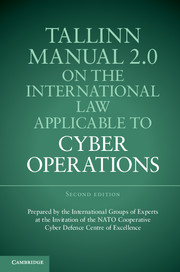70 results
Protecting the environment in armed conflict: Evaluating the US perspective
-
- Journal:
- International Review of the Red Cross / Volume 105 / Issue 924 / December 2023
- Published online by Cambridge University Press:
- 31 October 2023, pp. 1267-1292
-
- Article
- Export citation
Normative architecture and applied international humanitarian law
-
- Journal:
- International Review of the Red Cross / Volume 104 / Issue 920-921 / August 2022
- Published online by Cambridge University Press:
- 12 September 2022, pp. 2097-2110
-
- Article
- Export citation
Wired warfare 3.0: Protecting the civilian population during cyber operations
-
- Journal:
- International Review of the Red Cross / Volume 101 / Issue 910 / April 2019
- Published online by Cambridge University Press:
- 27 May 2019, pp. 333-355
-
- Article
- Export citation
Sovereignty in Cyberspace: Lex Lata Vel Non?
- Part of
-
- Journal:
- AJIL Unbound / Volume 111 / 2017
- Published online by Cambridge University Press:
- 22 August 2017, pp. 213-218
-
- Article
-
- You have access
- Open access
- HTML
- Export citation
International law and the military use of unmanned maritime systems
-
- Journal:
- International Review of the Red Cross / Volume 98 / Issue 902 / August 2016
- Published online by Cambridge University Press:
- 27 July 2017, pp. 567-592
-
- Article
- Export citation
13 - Prohibition of intervention
- from Part III - International peace and security and cyber activities
-
- Book:
- Tallinn Manual 2.0 on the International Law Applicable to Cyber Operations
- Published online:
- 03 February 2017
- Print publication:
- 02 February 2017, pp 312-327
-
- Chapter
- Export citation
14 - The use of force
- from Part III - International peace and security and cyber activities
-
- Book:
- Tallinn Manual 2.0 on the International Law Applicable to Cyber Operations
- Published online:
- 03 February 2017
- Print publication:
- 02 February 2017, pp 328-356
-
- Chapter
- Export citation
Tallinn Manual 2.0 International Group of Experts and Other Participants1
-
- Book:
- Tallinn Manual 2.0 on the International Law Applicable to Cyber Operations
- Published online:
- 03 February 2017
- Print publication:
- 02 February 2017, pp xii-xviii
-
- Chapter
- Export citation
16 - The law of armed conflict generally
- from Part IV - The law of cyber armed conflict
-
- Book:
- Tallinn Manual 2.0 on the International Law Applicable to Cyber Operations
- Published online:
- 03 February 2017
- Print publication:
- 02 February 2017, pp 375-400
-
- Chapter
- Export citation

Tallinn Manual 2.0 on the International Law Applicable to Cyber Operations
-
- Published online:
- 03 February 2017
- Print publication:
- 02 February 2017
8 - Law of the sea
- from Part II - Specialised regimes of international law and cyberspace
-
- Book:
- Tallinn Manual 2.0 on the International Law Applicable to Cyber Operations
- Published online:
- 03 February 2017
- Print publication:
- 02 February 2017, pp 232-258
-
- Chapter
- Export citation
19 - Occupation
- from Part IV - The law of cyber armed conflict
-
- Book:
- Tallinn Manual 2.0 on the International Law Applicable to Cyber Operations
- Published online:
- 03 February 2017
- Print publication:
- 02 February 2017, pp 543-552
-
- Chapter
- Export citation
Introduction
-
- Book:
- Tallinn Manual 2.0 on the International Law Applicable to Cyber Operations
- Published online:
- 03 February 2017
- Print publication:
- 02 February 2017, pp 1-8
-
- Chapter
- Export citation
Index
-
- Book:
- Tallinn Manual 2.0 on the International Law Applicable to Cyber Operations
- Published online:
- 03 February 2017
- Print publication:
- 02 February 2017, pp 569-598
-
- Chapter
- Export citation
6 - International human rights law
- from Part II - Specialised regimes of international law and cyberspace
-
- Book:
- Tallinn Manual 2.0 on the International Law Applicable to Cyber Operations
- Published online:
- 03 February 2017
- Print publication:
- 02 February 2017, pp 179-208
-
- Chapter
-
- You have access
- HTML
- Export citation
Part I - General international law and cyberspace
-
- Book:
- Tallinn Manual 2.0 on the International Law Applicable to Cyber Operations
- Published online:
- 03 February 2017
- Print publication:
- 02 February 2017, pp 9-176
-
- Chapter
- Export citation
7 - Diplomatic and consular law
- from Part II - Specialised regimes of international law and cyberspace
-
- Book:
- Tallinn Manual 2.0 on the International Law Applicable to Cyber Operations
- Published online:
- 03 February 2017
- Print publication:
- 02 February 2017, pp 209-231
-
- Chapter
- Export citation
9 - Air law
- from Part II - Specialised regimes of international law and cyberspace
-
- Book:
- Tallinn Manual 2.0 on the International Law Applicable to Cyber Operations
- Published online:
- 03 February 2017
- Print publication:
- 02 February 2017, pp 259-269
-
- Chapter
- Export citation
4 - Law of international responsibility
- from Part I - General international law and cyberspace
-
- Book:
- Tallinn Manual 2.0 on the International Law Applicable to Cyber Operations
- Published online:
- 03 February 2017
- Print publication:
- 02 February 2017, pp 79-167
-
- Chapter
- Export citation
Tallinn Manual 1.0 International Group of Experts and Other Participants2
-
- Book:
- Tallinn Manual 2.0 on the International Law Applicable to Cyber Operations
- Published online:
- 03 February 2017
- Print publication:
- 02 February 2017, pp xix-xxii
-
- Chapter
- Export citation

